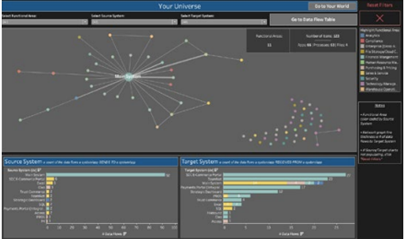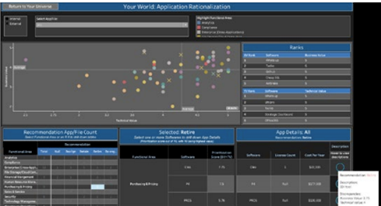Empowering Businesses for the Future: Technology Optimization Model Explained
As the marketplace evolves, business uncertainty remains a constant. Regardless of industry – political, technological, economic and environmental instabilities are shaping the current landscape of business, and the future is unpredictable. Undeniably, given the events of recent years, conducting business today is riddled with higher risk and fierce competition. Yet, amidst the heaviness of the current outlook, opportunities for businesses to thrive remain unprecedented. Advances in technology and the corresponding proliferation of big data have created a gateway for organizations to gain the greatest visibility into designing their futures – they need only pave the way.
Future of Work Tools – Paving the Way
Cultivating an innovative work environment keenly focused on the future of work creates a framework where leadership and employees are comfortable with ambiguity, because they have an arsenal of tools, skills and resources at their disposal.
Likewise, organizations must relentlessly monitor and understand events that span the globe and consumer demands with a preparedness to easily pivot in the potential of both indirect marketplace and direct organizational consequences. While these factors can significantly impact an organization’s ability to thrive both now and in the future, how an organization leverages advanced technologies and corresponding data has perhaps the most consequential impact.
Advanced Technologies and Analytics
Advanced technologies, including cloud-based collaboration solutions, adaptive AI (artificial intelligence) powered-tools, hyperautomation and metaverse technologies are enabling innovation in a formerly impossible way. Demand for insights and the need for visibility has given rise to the necessity of self service and democratized data across organizations. Analytics and business intelligence are omnipresent across all business sectors, and they are no longer a competitive advantage but a “must have” component in an organization’s functional business tapestry.
Where to Start – Organizational Visibility
All things considered, where does an organization begin? New, well-intentioned and established organizations all face a daunting task of navigating their business to be future-ready when uncertainty is the constant change. Organizations need end-to-end visibility into their organization so they can constantly adapt to and shape their environment and in turn, control their projected business outcomes.
Strategic planning is paramount for organizational success. Therefore, an essential first step is understanding the organization’s business objectives and strategies – what are they trying to accomplish? Understanding this initial step will keep an organization vigilant with its end goal. Therefore, beginning with an organization’s most established assets – the technology they employ and the processes they execute, applying the use of the Technology Optimization Model will enable organizational visibility.
Technology Optimization Model
Leveraging Cherry Bekaert Digital Advisory’s proprietary model, the team have built an interactive technology and process model where users see, understand and interact with their data. The tool is a series of dashboards whereby organizational data is used to review business processes, associated supporting systems, and applications and their interdependencies. The visualization model allows the business owner to view the business through a variety of lenses (business, applications, infrastructure, data, etc.) For example, The Business Application Interdependency Dashboard enables users to see how business processes are supported by applications, identifying the interdependency of business process and data with inputs and outputs. Organizations must be able to evaluate their systems and processes and the interdependencies to make better informed and effective decisions. The Technology Optimization Model allows business leaders the opportunity to visualize and interact with their data, gaining an in-depth understanding of how operatively their systems, processes, roles and costs are interconnected.

By gathering reliable information and data, business leaders can begin to make more informed decisions on which systems should be upgraded, modified or retired and the technical risks associated with these actions. Using key values that are important to an organization, the Rationalization Dashboard helps organizations determine which systems are best aligned to the overall business strategy and those that may not be as important as they originally seemed.

Technology Optimization Model for Extensive Applicability
Once business leaders gain this type of access and visibility into their organization, the application to use the model application blends into other functions. The model can apply and further benefit these functional business areas:
- IT Strategy & Architecture
- Business Process Re-Engineering
- Managed Services
- Fractional CxO Services
- Business Continuity
- Technical Business Management (Costing)
- Workforce Realignment
Technology Optimization Model Outcomes
Establishing full visibility and consistency throughout organizational processes and systems creates an opportunity for effective change. Leveraging the Technology Optimization Model helps organizations define their current business state to achieve their future objectives. Organizations can easily recognize and eliminate redundant technologies and inefficient business processes, while understanding the risk and impact these changes may have on other business areas. Likewise, the model provides business leaders with a comprehensive perspective on all available data, storage and governance, along with an overview of costs – both indirect and direct. Applicability of the model extends into critical organizational areas like Managed Services and IT in understanding which servers and applications may be affected. For example, with policy changes or perhaps with cybersecurity to understand which applications connect with which business users. This model can perform as a springboard into Business Process Management initiatives as it outlines and defines which processes are most critical. The Model helps organizations to ask decisive questions, invoke dialogue and make more informed decisions as to whether their current processes and supporting systems are aligned with the business strategy.
We can help you assess your organization’s current state to identify and prioritize strategic opportunities to take your business to the next level. Interested in a Technology Optimization Model assessment? Reach out to us today to get started!
How Cherry Bekaert Digital Advisory Can Guide You Forward
Cherry Bekaert’s Digital Advisory team is comprised of strategists who have broad industry experience and keen business acumen. Utilizing an agile and flexible approach, we examine what you want to achieve with a focus on people, process, technology and culture. Many recognize the need to create a data driven culture, and Cherry Bekaert is experienced in helping clients define, map and execute on that journey while addressing the organization’s risks, enabling growth and supporting sustainable operations. Leveraging our strategic process, we help digitally enabled organizations – especially middle-market companies – do more with less. Our team stays on top of the latest technology trends, but we know that technology is not a one-size-fits-all solution. Cherry Bekaert is here to guide you on what solution is appropriate and relevant for you to adopt as it pertains to delivering the highest value to your organization.
